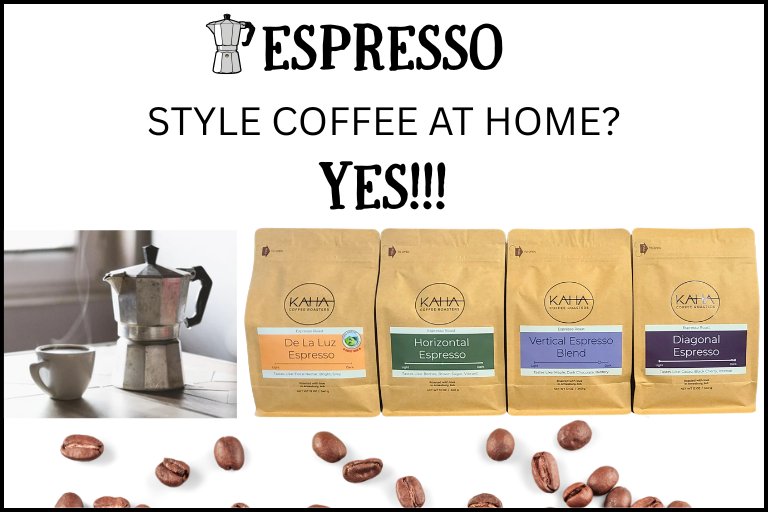Espresso-Style Coffee at Home? Yes!!!
By Tyler Workman

Brewing Espresso-Style Coffee at Home with the Mokapot
There’s a quiet hiss on the stovetop, a soft gurgle, and then an aroma that fills the air: deep, chocolatey, and rich! For nearly a century, this simple brewer has been turning kitchens of all types into miniature Italian cafés, offering a deep, strong cup that bridges the gap between drip coffee and true espresso.
But can you REALLY get espresso-style coffee at home with a mokapot? The answer is YES! With the right technique, and a little attention to detail, you can brew a cup that captures the intensity, texture, and satisfaction of espresso without the learning curve and cost of a high-pressure espresso machine and espresso grinder.

A Brief History of the Mokapot
Invented in 1933 by Italian engineer Alfonso Bialetti, the mokapot, officially named the Moka Express, was a revolution in home brewing. It produced a rich, concentrated coffee, giving everyday people a way to enjoy café-style coffee at home during a time when espresso machines were exclusive to bars and restaurants.
Its design is ingenious: three separate chambers for water, coffee grinds, and brewed liquid, connected by a simple pressure valve. When heated, steam builds in the lower chamber, forcing hot water up through the coffee grounds and into the top section. The result is a dense, aromatic brew that sits beautifully between filter coffee and espresso.
Nearly a century later, it’s still a staple across Italian households and increasingly, a favorite among specialty coffee lovers who value ritual as much as flavor.

The Modern Moka: Getting Closer to Espresso
The mokapot doesn’t reach the nine bars of pressure that define espresso, but it’s capable of producing something very close: a rich, full-bodied coffee concentrate with bold character and deep sweetness.
The key is in the details: grind size, water temperature, and heat control.
1. Grind Size
We here at KAHA Coffee Roasters believe that grind size matters quite a bit for the mokapot. Most people will grind quite fine, slightly coarser than espresso for the mokapot. The general thought is that you should grind fine enough to create resistance but not so fine that it clogs the filter or produces bitterness. We take a different approach and will usually grind to a drip coffee grind size (about medium to medium coarse). We also believe that each espresso, depending on roast level, freshness, and density will require its own grind size. For example, we get a very rich and smooth brew using our Vertical Espresso ground at a drip coffee grind size, while the Diagonal Espresso we feel does better at a more coarse grind size (medium coarse). One thing we really recommend when brewing with the mokapot is to use a burr grinder for grind consistency instead of a blade-type grinder (spice grinder style).
2. Pre-Heat Your Water
Pro Tip... start with hot water in the bottom chamber. This step shortens the time the mokapot spends on the stove, reducing the risk of scorching the coffee and yields a smoother and cleaner cup. If you have a temperature controlled water kettle, we like to set it in the range of 200-205 degrees Fahrenheit. CAUTION: Be sure to use a dish cloth or towel to hold the bottom chamber when screwing the top chamber on so as not to burn yourself.
3. Don’t Tamp
Unlike espresso preparation, you don’t tamp a mokapot basket. Fill it evenly and lightly level it off. Over packing restricts water flow, causing over extraction and bitterness.
4. Heat Low and Slow
Use gentle, steady heat. Let the coffee rise gradually. Too much heat and you’ll scorch the coffee. Listen for the soft bubbling sound, and remove the pot from the burner at the first sputter.
5. Stir Before You Pour
Once the coffee has finished brewing, swirl or stir the top chamber to mix the layers for a more balanced flavor.
Flavor Expectations
A well-brewed moka pot coffee carries many of the hallmarks of espresso: syrupy body, concentrated flavor, and a long, chocolatey finish. You’ll find it slightly less intense in crema and pressure-derived oils, but beautifully rich nonetheless—especially with medium or dark roasts.
Take It Up A Level With Milk
Combined with steamed or frothed milk, a mokapot base makes a great home latte or cappuccino, delivering the same cozy satisfaction of a café drink.
To take your espresso-style drinks up a level, add a milk frothing or foaming wand for home cappuccinos, lattes and more! Our favorite is the Nanofoamer V2, but any milk frothing wand will work!

Our Notes For Brewing KAHA Coffee Espresso Roasts
We've brewed all of our espresso roasts in the mokapot to ensure a great espresso taste at home using the mokapot.
De La Luz Light Roast Espresso - This direct trade coffee, from our partners at Siempre Verde Farm, is a bright silky espresso with a floral nectar sweetness that delivers a unique light roast experience in the mokapot. Start with a drip coffee sized grind size. If the coffee tastes a little flat, try a slightly finer grind size.
This light roast coffee needs more time to off-gas than our other espresso roasts, so try to shoot for 10-12 days after the roast date to brew in the mokapot. If this coffee is too fresh, it will bloom inside the mokapot chamber and create channeling which will result in an under extracted brew.
How we drink it: We enjoy the De La Luz light roast espresso best as a straight shot from the mokapot, or as an Americano.
Horizontal Medium Roast Espresso - This single origin Colombian coffee from the Huila region is user friendly and should brew perfectly at a drip coffee sized grind size. This coffee should be allowed to off-gass/rest about 6-8 days after the roast date. The resulting brew is a complex and vibrant espresso-style brew that is sure to wake you up.
How we drink it: We enjoy the Horizontal medium roast espresso as a straight shot from the mokapot, with frothed milk as a cortado, or with a teaspoon of sweetened condensed milk.
Vertical Dark Roast Espresso - Our original espresso roast produces a smooth and sweet dark roast with no bitterness. Perfect for those looking for a rich silky smooth espresso-style drink with a pronounced sweetness. Since it is a dark roast, you can brew it in the mokapot closer to the roast date without needing to have it off-gas/rest for long. Using a drip coffee grind size should be perfect for the Vertical Espresso.
How we drink it: We enjoy the Vertical dark roast espresso best as a straight shot from the mokapot, as an Americano, or with just a bit of frothed milk and a few drops of agave nectar.
Diagonal Dark Roast Espresso - The dark roast punchy enough to stand up to frothed milk, and shines as a cappuccino! Because this is a dark roast with four different origins in the blend, you may need to adjust grind size for your mokapot. We found that going slightly coarser than drip coffee grind size works best to avoid the chance of any bitterness.
How we drink it: We enjoy the Diagonal dark roast espresso best as a macchiato, cortado, cappuccino, or an americano.
Why We Love The Mokapot
In the world of specialty coffee, the mokapot holds a special charm. It represents craft, ritual, and a beautiful simplicity. It rewards care and patience but doesn’t demand perfection or expensive equipment. It’s also portable, nearly indestructible, and steeped in history. Its proof that simple tools can still yield extraordinary cups.
Final Thoughts
Espresso is beautiful complex, fast, and precise. But the mokapot reminds us that the heart of espresso isn’t the pressure gauge or the stainless-steel casing it’s the pursuit of flavor, balance, and pleasure in the cup.
With a few tweaks and a little practice, you can absolutely get that espresso-style richness right on your own stovetop. The mokapot has been doing it since 1933 and it’s not going out of style anytime soon.


0 comments